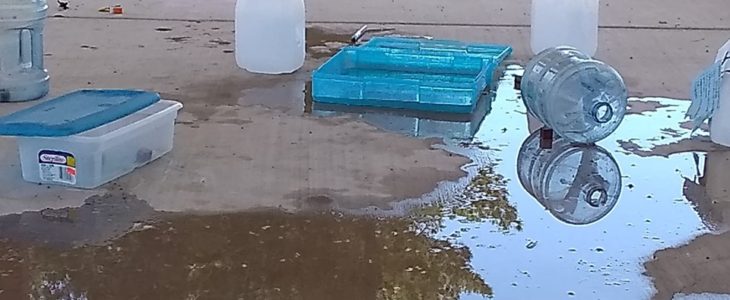

Water, thank you! You helped gather kids from half a dozen families around a little tub of toys on a nearly-100-degree morning, to splash, giggle, and even share. You sustained tomato plants I thought were done for, with the help of morning shade so they didn’t fry. You made mud to play in too, the bright side of clay so dense it choked out the strawberry plants. Thank you Marana Parks and Recreation for spreading the word for the Water Play class, and thank you water for keeping us cool.
Water? In June? Where does it come from? Not much at all from the sky. June marks the lowest average rainfall of all the months if you live in Southern Arizona. It’s also the hottest month. Water transpires quickly from plants, causing native plants to go dormant while waiting for the monsoons. Garden plants wither without daily – sometimes twice daily – water from their people. If you harvested rainwater this spring, you might have some remaining to use. Desert dwellers primarily water plants and themselves from pumped water.
Groundwater is key. Even though the Santa Cruz River rarely flows through town, the aquifer of the Santa Cruz Watershed is metro Tucson’s main water supply. “Wells bubble bubble up,” goes the water cycle song I lead in class. If you live in metro Tucson and don’t own a well, your water is pumped by Tucson Water, Metro Water, or Marana Water wells.

It’s also true that we are using our groundwater faster than rain can trickle down through the rock and sand to replenish it. How can we sustain the current and growing population of people? On a supply level, municipalities now count on water from the Colorado River as well as locally treated wastewater to supplement and/or replenish the water we pump up. A less visible system of trade and storage credits contributes to the equation.

Conservation Is also key. Here’s where individuals can take responsibility but also get creative. Personally, I choose fake grass and native or desert-adapted shrubs to reduce water use in the yard – but splurge on daily watering for the beds of flowers and veggies I love to tend. We filled in our pool. A wading pool suffices, and for several summers my kids took baths outside: double duty to cool off and to water the oak tree afterwards by dumping the tub. I’m guilty of medium-length showers even through Girl Scout Camp taught me the skill of sticking to 3 minutes. We would love a grey-water system or large rain barrel – and feel a little better at least directing rainwater to trees and compost. What does your mix-and-match of conservation efforts look like? Would you like a private lesson to explore what’s right for your yard?
That we can always do more is true for water conservation just as it is with work, family, community, and self-care. Can using water also be a bridge? Students coming together to share a 1-inch-deep water demo points to “yes”. So does my husband joining my boys and me to fill our small pond, and volunteers at Miles stepping up to sustain fruit trees during summer vacation. My calling a wading pool an “outside bathtub” 5 years ago truly helped my survival as a parent one especially hard summer – and that summer of practical water play planted the seed of Nature to You in my mind. Thank you, water.

Photos by Anna Van Devender unless otherwise stated.

